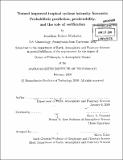Toward improved tropical cyclone intensity forecasts : probabilistic prediction, predictability, and the role of verification
Author(s)
Moskaitis, Jonathan Robert
DownloadFull printable version (36.80Mb)
Other Contributors
Massachusetts Institute of Technology. Dept. of Earth, Atmospheric, and Planetary Sciences.
Advisor
Kerry A. Emanuel.
Terms of use
Metadata
Show full item recordAbstract
Over the past two decades, deterministic predictions of tropical cyclone (TC) intensity consistently scored poorly in mean absolute error (MAE) verification, despite the concurrent advancement of TC modeling and observing capabilities. Given the importance of understanding this situation for the future of TC intensity prediction, the "TC intensity prediction problem" is examined here on two fronts: (1) the role of verification in driving the forecast system development process, and (2) the inherent limit of predictability under the extant TC observing network. Verification is first examined from a theoretical perspective. It is shown that the use of certain summary measures of probabilistic forecast performance in the forecast system development process should be favored, because those summary measures promote production of theoretically-optimal predictions. However, the choice of a summary measure for verification of deterministic forecasts is arbitrary, since theoretically-optimal predictions cannot be produced by a deterministic forecast system. It is also demonstrated that the summary measure used in development of TC intensity forecast systems, MAE, does not necessarily drive development of a deterministic dynamical model toward the true system dynamics. A dynamical model should instead be developed in the context of ensemble prediction. Within the current operational environment of deterministic TC intensity prediction, it is shown that MAE provides a very limited view of forecast quality relative to the joint distribution of forecasts and observations. Analysis of the joint distribution reveals the profound influence of MAE-driven TC intensity forecast system development on the quality of operational predictions. Furthermore, the joint distribution inspires an information-theoretic summary measure with appealing properties. (cont.) The predictability of TC intensity is examined in the context of a simple dynamical TC model (the Coupled Hurricane Intensity Prediction System), in which it is feasible to explore an extensive phase space of initial conditions and idealized environmental boundary conditions. Lessons learned about the sensitivity of the simulated intensity are used to interpret ensemble predictions of real TCs. These ensemble predictions, and the associated estimates of analysis error used in formulation of the ensemble perturbations, represent a key step forward toward the goal of real-time probabilistic prediction of TC intensity.
Description
Thesis (Ph. D.)--Massachusetts Institute of Technology, Dept. of Earth, Atmospheric, and Planetary Sciences, 2009. Includes bibliographical references (p. 207-214).
Date issued
2009Department
Massachusetts Institute of Technology. Department of Earth, Atmospheric, and Planetary SciencesPublisher
Massachusetts Institute of Technology
Keywords
Earth, Atmospheric, and Planetary Sciences.